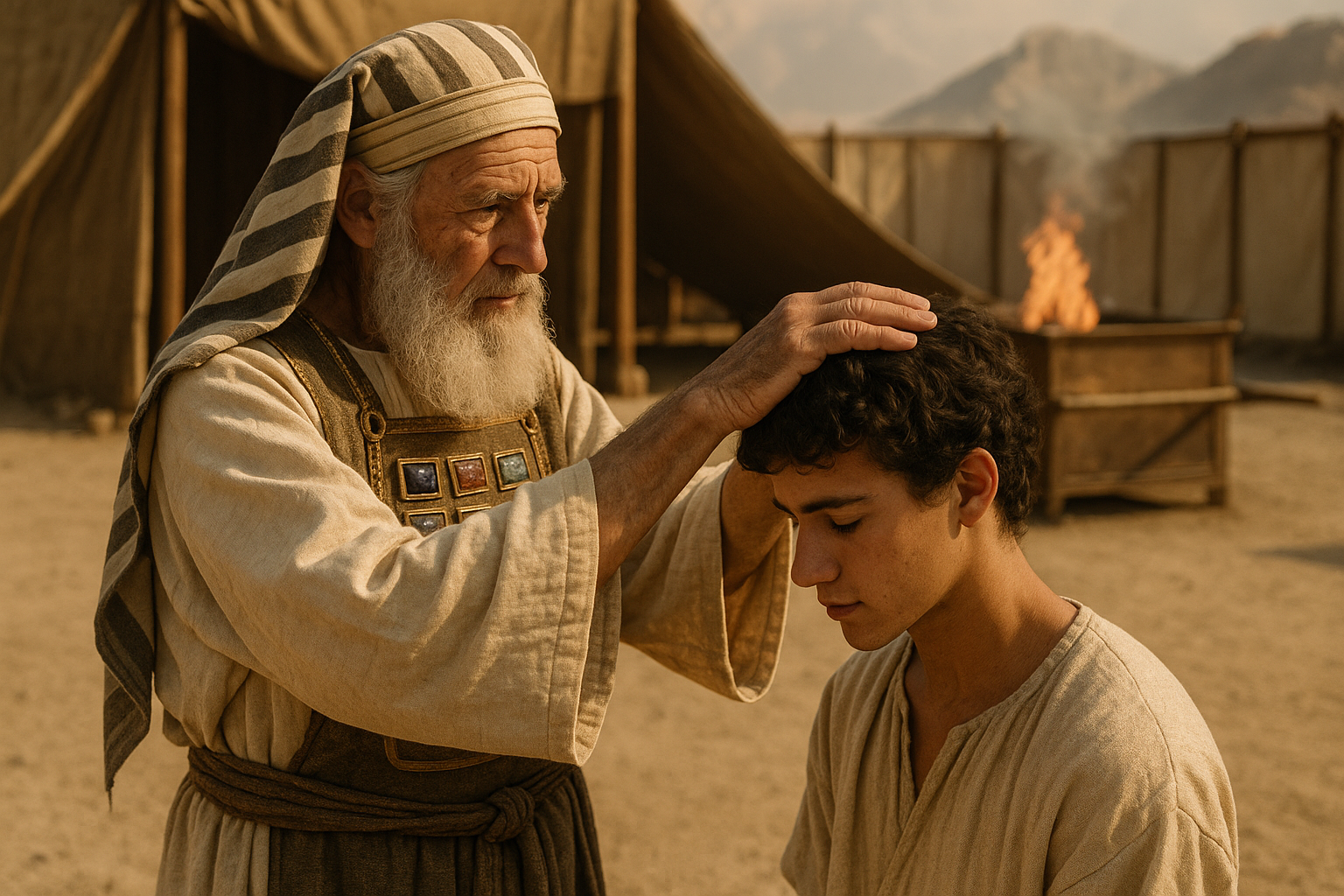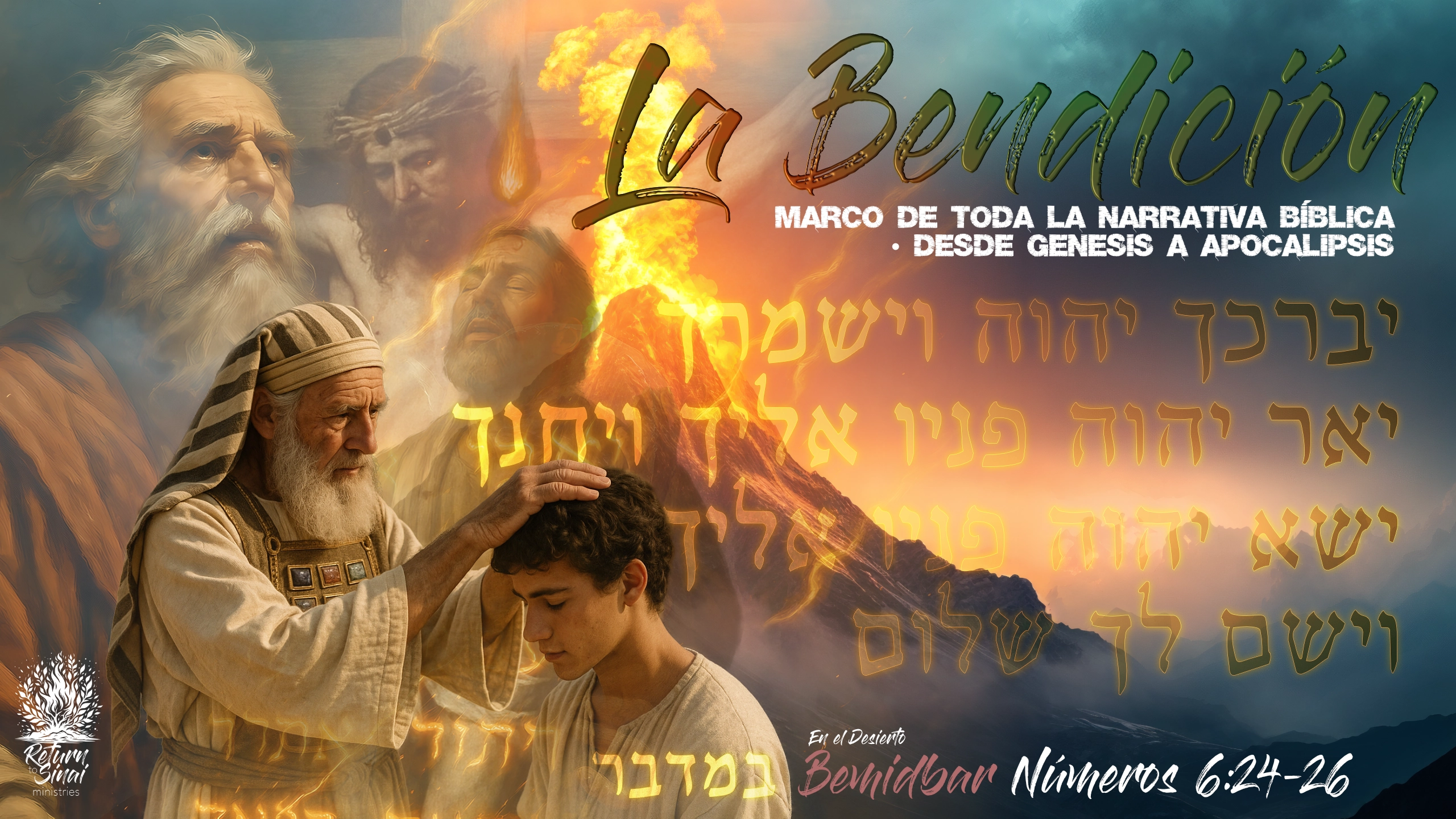EL MARCO DE TODA LA NARRATIVA BIBLICA DESDE GENESIS HASTA REVELACIÓN.
Desde Génesis hasta Apocalipsis, la Bendición Aarónica encapsula la relación de Yahweh con Su pueblo, entrelazando temas de favor divino, revelación y restauración. Pronunciada por Yahweh y entregada a Aarón y sus descendientes, esta bendición no es simplemente una oración—es una declaración de la fidelidad de Yahweh, reflejando Su plan redentor a lo largo de la historia.
El Texto de la Bendición
(Números 6:24-26)
יברכך יהוה וישמרך יאר יהוה פניו אליך ויחנך ישא יהוה פניו אליך וישם לך שלום

Traducción
Que Yahweh te bendiga y te guarde. Que Yahweh haga resplandecer Su rostro sobre ti y te muestre favor. Que Yahweh levante Su rostro hacia ti y te conceda paz.
Esta bendición no un texto aislado—refleja toda la narrativa bíblica, desde el pacto de Yahweh con Abraham, Su revelación en el Sinaí, hasta la obra redentora de Yeshua.
Porque de tal manera amó Dios al mundo, que ha dado a su Hijo unigénito, para que todo aquel que en él cree, no se pierda, mas tenga vida eterna.
Juan 3:16 • Versión Reina Valera 1960 (RV60)
Un patrón triple: Bendición, Favor, Restauración.
1. Yahweh Bendice a Abraham (יברכך יהוה – "Que Yahweh te bendiga")
El verbo ברך (barach) transmite favor divino, prosperidad y multiplicación. Esto se conecta directamente con Génesis 12:2-3, donde Yahweh bendice a Abraham, diciendo: "Te bendeciré... y en ti serán benditas todas las familias de la tierra."
Las intenciones de Yahweh siempre han sido bendecir a toda la creación. Al bendecir a Abraham con una perspectiva restaurada, evocadora del Jardín del Edén, se puso en marcha el proceso de reconciliación. No se trata de una visión nueva, sino de un enfoque renovado—uno que nos permite regresar al principio mismo, para deshacer lo que hizo Adán. Nos ofrece la oportunidad de elegir la vida una vez más, en lugar de depender de nuestras propias interpretaciones del bien y del mal. A través de las naciones que descienden de Abraham, estamos llamados a demostrar cuán magnífico habría sido el mundo si Adán hubiera cumplido su propósito divino.
Yahweh desea bendecirnos con Su hermosa creación, reconciliándonos con Él y restaurando la relación que teníamos con Él en el Jardín. Esto ocurre al confiar en Su bendición y protección, y sobre todo, en Su perspectiva del “bien” y del “mal”, según Sus términos, no los nuestros.
Este tema se extiende a lo largo de la historia, llegando a su cumplimiento en Yeshua, through whom the promise of divine blessing extends to all who enter into covenant with Him.
Referencia Talmúdica::
- Mishnah Berakhot 9:5 – Enseña que uno debe bendecir a Yahweh por lo bueno y lo malo, reconociendo que todas las cosas ocurren dentro de Su plan divino. Esto refuerza la confianza necesaria para recibir Su bendición, como se ve en el camino de Abraham..1
2. Yahweh Hace Resplandecer Su Rostro en el Sinaí (יאר יהוה פניו אליך – "Que Yahweh haga resplandecer Su rostro sobre ti")
El verbo אור (or) means significa luz, iluminación, revelación. Cuando Yahweh descendió sobre el Monte Sinaí, Su presencia fue visible a través del fuego y el trueno (Éxodo 19). Este momento fue crucial—la entrega de la Torá, el resplandor de Su revelación sobre Israel.
Todo esto comenzó en Génesis 1. Todos los símbolos del estado de la Creación me resultan muy interesantes. La idea sobrecogedora de que todo cobra existencia por la Palabra de Yahweh, y luego es organizado por el consejo del Espíritu, es realmente asombrosa. Pero, por supuesto, esto plantea una pregunta...
¿Por qué la Tierra estaba vacía y sin forma desde el principio? Las implicaciones abren muchas más preguntas. ¿Por qué Yahweh creó todo en tal estado de caos? ¿Por qué no traer orden desde el primer momento? La respuesta a estas preguntas no es una simple queja agnóstica ni una burla sistemática atea. Las respuestas están reveladas a lo largo de la Escritura.
Y, por supuesto, esto—como creyente en Yahweh—te llevará a asociar la conversación con un Salmo muy famoso, y el más largo que se haya escrito: el Salmo 119.
Lámpara es a mis pies tu palabra, Y lumbrera a mi camino.
Psalmo 119:105 • Reina Valera 1960 (RV60)
La Palabra de Yahweh es lámpara, luz—luz que guía, para ser exactos. Las implicaciones son inmensas, y una vez más, la luz se convierte en un aspecto importante de la personalidad relacional de Yahweh con la creación. Y para este punto, quizá ya puedas responder las preguntas por ti mismo, si estás permitiendo que Su Espíritu te guíe.
Yahweh no desea una creación como una pintura que se realiza una vez y se cuelga en la pared, aunque siga pareciendo una obra maestra. Ni como un servicio de inteligencia artificial que puede ser fácilmente manipulado por programadores, incluso por robots, aunque la creación misma esté guiada por leyes físicas que han perdurado durante milenios. No, Yahweh quiere una creación que se relacione con Él y que voluntariamente lo busque.
Y no sólo buscarlo, sino obedecerlo y amarlo.
Este mismo tema se continúa con Yeshua, quien es llamado "la luz del mundo" (Juan 8:12). Así como Sinaí iluminó el pacto de Israel, Yeshua ilumina los corazones de aquellos que caminan en Sus caminos.
Referencia Histórica:
- Rollo de Plata Ketef Hinnom (Siglo VII a. C.) – La Bendición Aarónica fue encontrada inscrita en amuletos de plata en Jerusalén, confirmando su uso litúrgico temprano y su significado eterno de la presencia divina de Yahweh en medio de su pueblo.2

3. Yahweh Levanta Su Rostro en Redención (ישא יהוה פניו אליך – "Que Yahweh levante Su rostro hacia ti")
La raíz נשא (nasa) means significa levantar, cargar, exaltar o perdonar. Esta imagen evoca a un padre que levanta a su hijo, mirándolo con amor y deleite. Esto se relaciona con Salmo 103:13: : "Como un padre muestra compasión a sus hijos, así Yahweh muestra compasión a los que le temen."
Esto encuentra su máxima expresión en la obra redentora de Yeshua—la humanidad, antes separada, es levantada en Su favor a través de la fe.
Una imagen más clara o ejemplo fue representado por Yeshúa, primero a Su círculo íntimo de amigos, cuando se arrodilló para lavar sus pies malolientes durante la cena de Pascua . Pero fue llevado aún más abajo, hacia los peores pecadores, en la cruz. Como las tablas de piedra talladas por la mano de Yahweh y destruidas por nuestras transgresiones. —rompiendo literalmente toda la ley a la vez. Aun así, Moisés halló gracia ante Yahweh. Lo llamó Su amigo, con quien habla cara a cara.
Yeshúa se arrodilló para darnos vida. Levantó Su rostro hacia nosotros y dijo:
Y Jesús decía: Padre, perdónalos, porque no saben lo que hacen.
Lucas 23:34 • Reina Valera 1960 (RV60)
Referencia Talmúdica::
- Sefer HaChinukh – Explica que al recitar una bendición, se reconoce la soberanía de Yahweh y Su bondad. El levantamiento del rostro de Yahweh en la Bendición Aarónica representa la reconciliación y la restauración espiritual.3
Fe en el Desierto: El Mensaje del Evangelio.
Un aspecto clave de esta bendición es su contexto en el desierto. El desierto era un lugar de prueba, donde Israel tuvo que aprender fe en las promesas de Yahweh. Esto refleja todo el mensaje del evangelio: confiar en la bendición de Yahweh a través de Yeshuano por fe ciega, sino basada en Sus obras probadas a lo largo de la historia.
- Bendición en el desierto → Israel recibió el favor y protección de Yahweh en una tierra árida. No tenían recursos propios, su supervivencia dependía totalmente de Él.
- Fe basada en las obras anteriores de Yahweh Yahweh constantemente llama a Su pueblo a recordar—el Éxodo, Sus milagros, Su pacto con Abraham—todas pruebas de Su fidelidad en la historia. Esto reafirmó su fundación en la confianza de Sus promesas futuras.
- El Evangelio en el desierto → Yeshua pasó 40 días en el desierto, resistiendo la tentación y demostrando total dependencia en Yahweh. Israel también tuvo que aprender a confiar en Yahweh en el desierto, entendiendo que Su provisión y victoria venían únicamente de Yahweh.
Referencia Talmúdica::
- Comentario de Hirsch sobre la Bendición Sacerdotal – Explica que el sacerdote levanta sus manos hacia el cielo mientras recita la bendición, enfatizando que proviene directamente de Yahweh. Esto refleja la experiencia del desierto—Israel debía mirar hacia arriba en dependencia total de Su provisión y promesas..4
Conclusión: La Bendición como Narrativa Bíblica.
La Bendición Aarónica no es solo una oración final—es el resumen de toda la Escritura:
- La Bendición (Abraham’s covenant) → Favor (Iluminación / Revelation) (Sinai revelation) → Restauración (Redención en Yeshua).
La fe no es ciega— se basa en la fidelidad de Yahweh, sabiendo que lo que Él ha cumplido garantiza que todas Sus promesas serán cumplidas.
Esta bendición, dada en el desierto, es nuestra garantía de que Yahweh es fiely Su plan redentor es seguro.
Recursos
- Mishnah Berakhot 9:5 ↩︎
- Rollo de Plata Ketef Hinnom (Siglo VII a. C.) ↩︎
- Sefer HaChinukh ↩︎
- Comentario de Hirsch sobre la Bendición Sacerdotal ↩︎
Referencias Arqueológicas e Históricas
- Rollo de Plata Ketef Hinnom – Un amuleto hebreo antiguo con la inscripción de la bendición Aarónica, confirma su uso litúrgico desde la antigüedad. See it here
Referencias Rabínicas y Talmúdicas
- Sefer HaChinukh – Explicación sobre la bendición y su conexión con la soberanía de Yahweh. See more information here.
- Mishnah Berakhot 9:5 – Una enseñanza sobre bendecir a Yahweh en ambas ocasiones, buenas o circunstancias retantes. More information here.
- Comentario de Hirsch sobre la Bendición Sacerdotal – Un análisis detallado sobre la estructura de la bendición sacerdotal. More here.

Deja un comentario